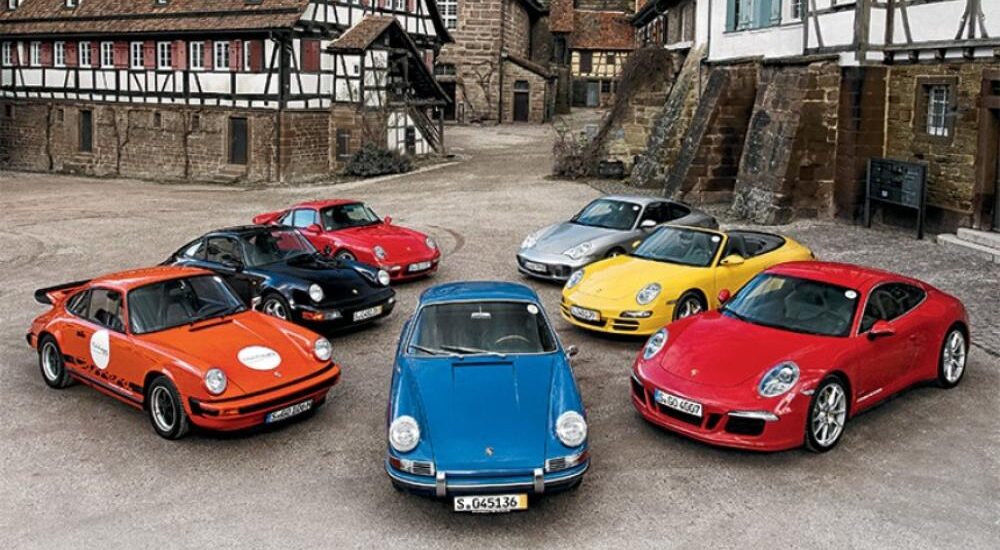Porsche 911’s half-century anniversary began to be celebrated in Stuttgart as early as the spring of 2013. In the summer, I had the opportunity to drive almost every generation of the 911 on the factory test track in Weissach. But upon returning, I dug deeper into the history. Why does the Porsche 911 officially have seven generations? Where is the line between the first and second? And if we’re being precise, the 50th anniversary of the Porsche 911 should actually be celebrated in the fall of 2014!
Every official history is somewhat distorted—powdered, embellished, and polished. Yes, the new Porsche model was first shown to the public at the 1963 Frankfurt Motor Show. But first, it was in the fall, in September. Second, the display at the IAA exhibition featured not a production car, but a prototype. And third, the model had a different designation—back then, it was the Porsche Typ 901!
Looking back fifty years, even in the winter of 1964, the Porsche 911 didn’t exist yet. The car was still in the preparation stages under the name Porsche 901. It would only enter production in the summer, with the first deliveries to customers starting in September of 1964. At the time, pre-production prototypes were simply being driven around the test track in Weissach.
And in those years, this test track didn’t even exist—there was only the “skid pad,” a large, paved circle. The handling course would be built later, in 1971, and… What a fantastic track it is!
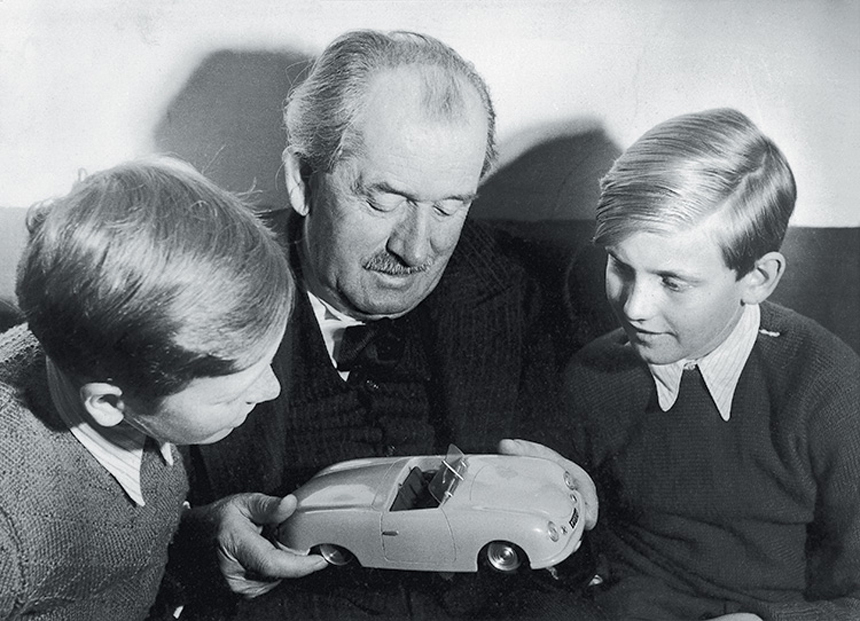
1949: The history of the brand began with this mid-engine roadster model, which Ferdinand Porsche lovingly shows to his grandchildren. On the left is Ferdinand Porsche, the grandson, nicknamed Butzi, and on the right is Ferdinand Piëch, the son of Porsche Sr.’s daughter Luise Piëch: both will enter the family car business
It’s far more exciting than Alfa Romeo’s track in Balocco. You fly into a sharp left-hand bend, cut through a fast right turn, then with braking, you dive steeply left and fall downward, even more dramatically than in the Nürburgring carousel…
And it’s surprising how dull the very first Porsche 911 drives here.
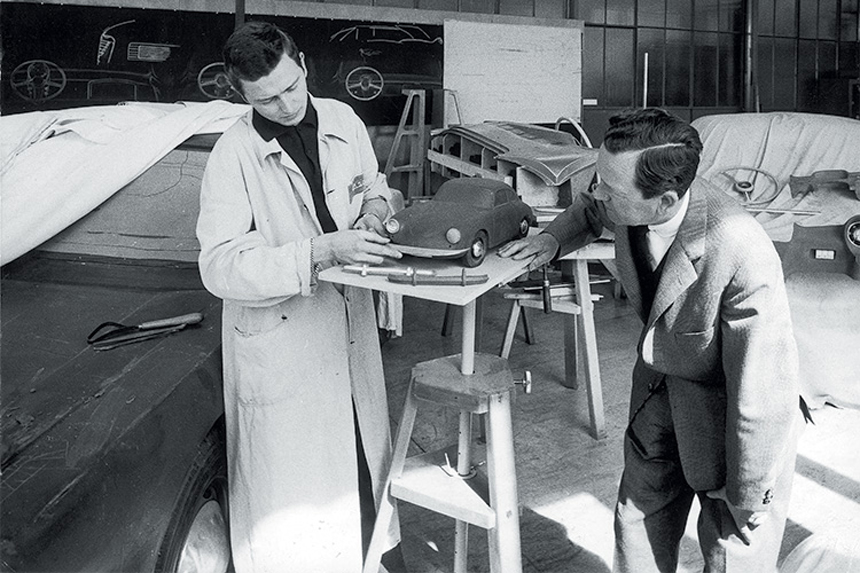
1959: Butzi Porsche the grandson has grown up and is already running a design studio near the Austrian lake Zell am See. On the right, by the model of the Porsche 356, is his father Ferry Porsche, who is overseeing the development of the future “nine hundred and eleven”: for now it exists in the form of a full-size model proposed by Butzi (in the left corner of the frame)
Simple little chairs, lap seat belts, a thin steering wheel, floor-mounted pedals with archaic kinematics, a long-throw shifter that was already five-speed from the beginning—an innovation for the time. The seating position is uncomfortable, with legs splayed apart, the steering wheel almost touching the knees, and the two-liter flat-six engine with just 130 hp humming blandly. Acceleration is sluggish—on a straight, it’s a struggle to hit 150 km/h on the speedometer. And handling… Where is that infamous tendency to oversteer, for which the 911 was criticized? It’s a calm, comfortable, and well-balanced car.
In fact, automotive journalists of the time noted that the early Porsche 911s had almost lost the “rear-engine characteristic” that was typical of the previous Porsche 356 model. And that’s exactly how it was designed!

And this is already the summer of 1964, but the Porsche 911 does not yet exist! Both pre-production cars in this photo – chassis #4 on the left and #2 on the trolley jack – bear the index 901. I wonder what Ferry Porsche is telling his son Butzi? “See, I told you – you can’t do that…”
It all began in 1956, five years after Ferdinand Porsche’s death, when he had divided the company between his elder son, Ferry, and his eldest daughter, Louise Piëch. But the practical Louise was more focused on the business side—she took charge of the family business selling Porsches and Volkswagens in Austria, while the automotive side was run by Ferry Porsche with the help of his son, Ferdinand Alexander, nicknamed Butzi. A family affair!
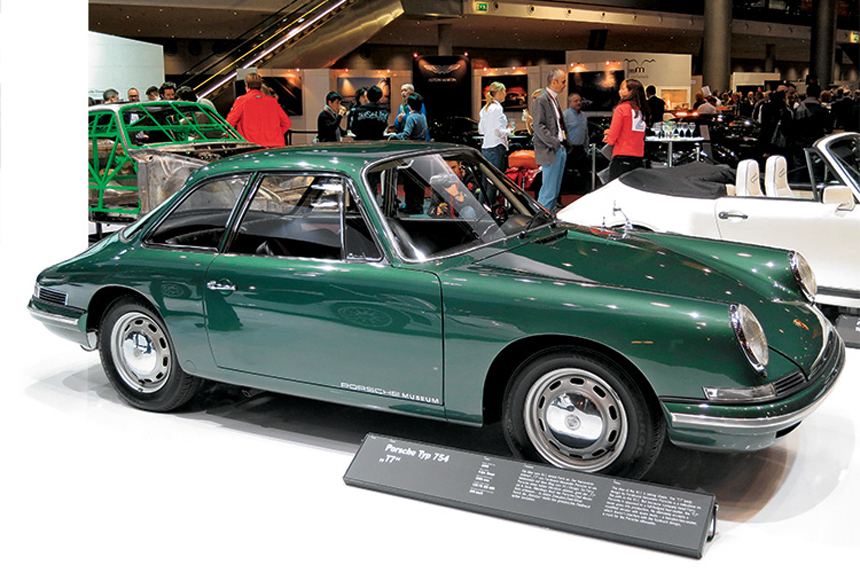
This is how Butzi Porsche envisioned the Porsche 901 to look like — the T7 prototype built in 1959 has two more or less full-fledged rear seats
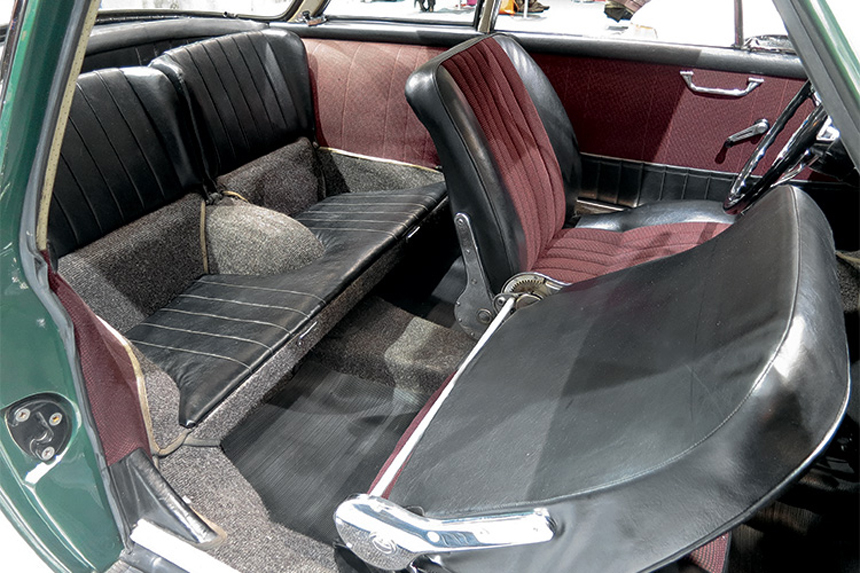
What a blessing that the body shape didn’t suit my father back then…
And how fortunate it was that Papa, Ferry Porsche, had the taste to insist on the teardrop shape! It was Butzi, Porsche’s grandson, who made the first sketch of the future “911” in 1959. The new model was meant to be a sports tourer, a kind of Gran Turismo—six cylinders were chosen primarily for smooth operation. The rear body was lengthened to fit two full-size passenger seats. Ferry believed that the angular “trunk” body shape improved aerodynamics, and he insisted that aesthetics had to be sacrificed for driving qualities. Even his race cars were made with such bodies: for example, the lightweight Porsche 356B 2000 GS Carrera GT (third place at the Targa Florio, by the way) had the same roof as the first prototypes of the future “911” and was nicknamed the “Scraper.”
Thus, the Porsche Typ T8 was born, and based on this, the first prototypes were made at the Karmann body shop in 1963—one of them, yellow-lemon in color, still with a steering wheel from the Porsche 356, was first presented at the September 1963 IAA Frankfurt Motor Show.
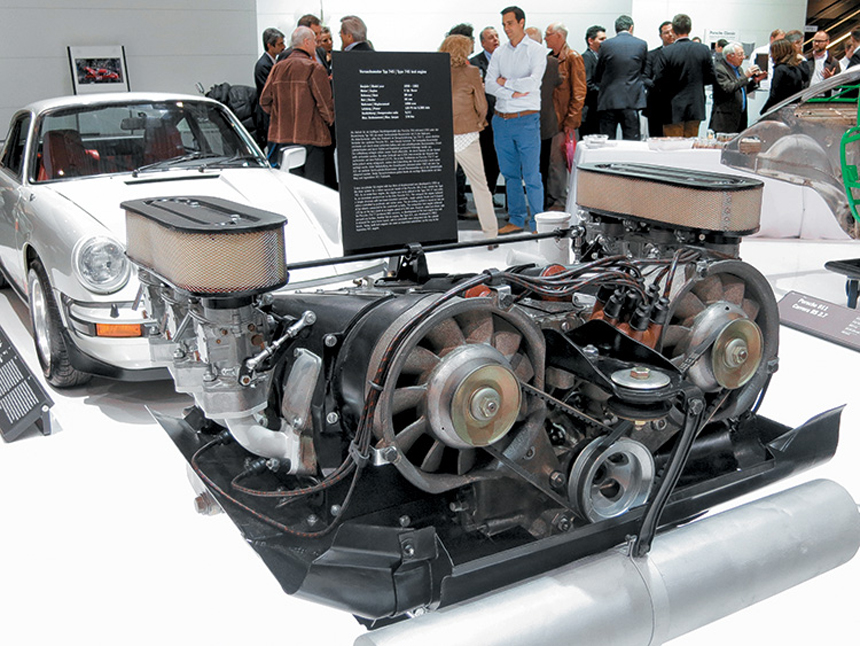
And this is an early (1959-1962) prototype of a six-cylinder engine, still with two “lower” camshafts and two cooling fans: 120 hp and 170 Nm were removed from a two-liter volume. But this path was recognized as a dead end, and the next experimental “six” in 1962 was overhead and with one fan.
Oh yes, this was a huge leap forward compared to the Porsche 356! Practically no parts from the Beetle, overhead-valve flat-six, disc brakes, rack-and-pinion steering, and although the suspension was torsion-bar, it featured McPherson struts in the front and trailing arms in the rear instead of the archaic swinging half-axles of the 356. And unexpectedly narrow (165 mm) radial 15-inch tires.
You probably remember the story about changing the 0 to a 1—Peugeot insisted that the Germans could not use the 901 designation in France. But while the dispute was ongoing, the first batch of production cars had already been made with “901” badges. So, the Porsche 911 name didn’t officially appear until October 1964!
And then it began: the car changed almost every year. In the middle of 1966, the temperamental Solex carburetors were replaced with Weber units and CV joints were introduced. In 1967, they tried to improve the balance with front ballast, placing two 11-kg weights in the front bumper, but this was only a temporary solution—later they were removed, and instead, the upper strut mounts were moved to change the geometry of the front suspension. A rear stabilizer bar was added to some versions. In 1968, tires became wider, and in 1969, the wheelbase was lengthened…
And now I understand why—after taking three laps on the test track in the 1980s Porsche 911.
Guys, this is an entirely different car!
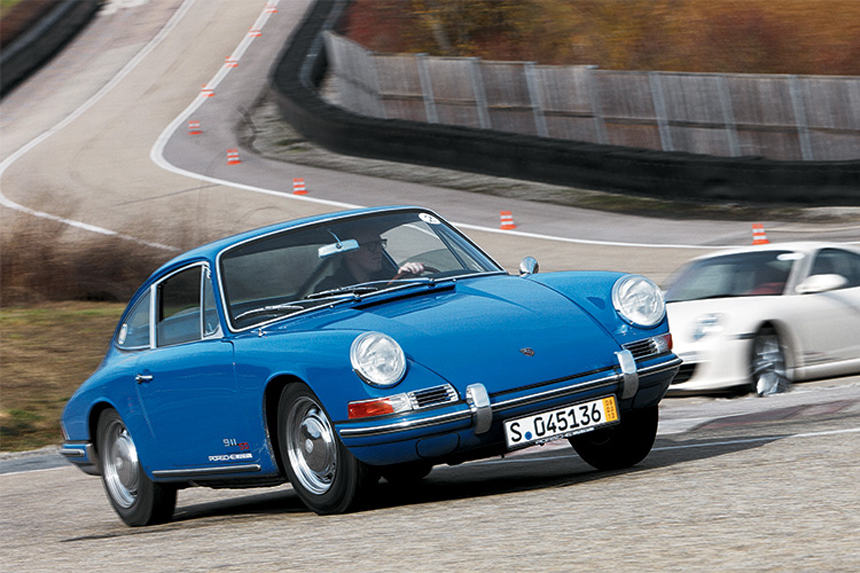
An early Porsche 911, still short-wheelbase, behaves quietly on the Weissach test track, although at that time
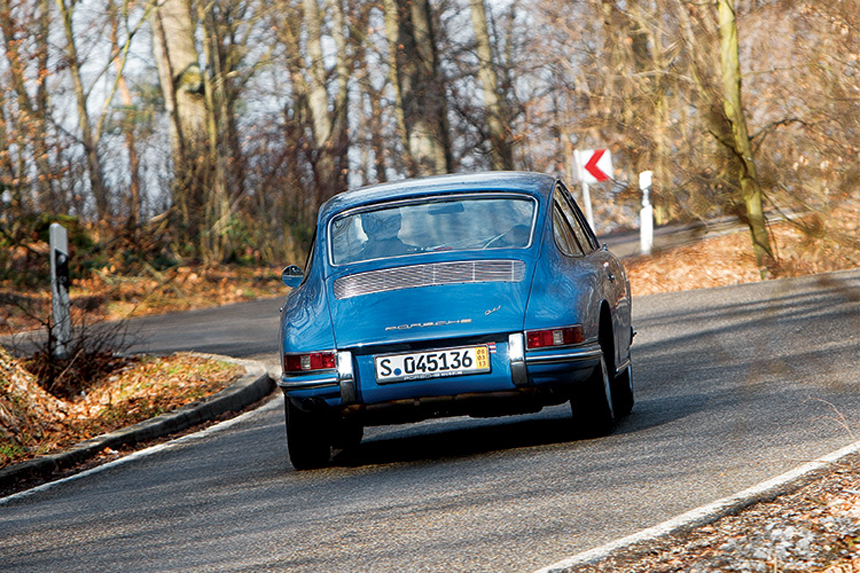
In the sixties, there were few faster cars
The seating position, steering feel, reaction precision, acceleration—all of it is different. On the same straight stretch of the test track, 150 km/h is easily reached—and you keep attacking. Gear shifts are easier and more precise—this is a different, stronger gearbox. And handling… It’s ideal, a dream! All these years in Weissach, they fought to return that characteristic rear-drive feel without compromising safety—and they nailed it. On the G-series corners, the car enters eagerly, predictably sliding the front when needed or going into a slight drift when lifting off the throttle, which you catch with the power, and…
What I don’t understand is why Porsche considered this car a separate, second generation. They say it was produced from 1973 to 1988. But that’s not true!
All the major stages of development were lettered. For example, the wheelbase lengthening in 1969 was series B. The first engine displacement increase to 2.2L in 1970 was series C, and the second increase to 2.3L with a longer piston stroke in 1972 was series D… Series G and H were upgrades from 1973-1975: 2.7L engines, lightweight suspension arms instead of steel, and color-matched bumpers. But all this was just a series of modifications and light cosmetic changes: in reality, the Porsche 911 from 1964 to 1988 was the same car, produced for 25 years. A quarter of a century.
And honestly, I don’t see anything offensive about this in Porsche’s official history. And how dramatic that history was! “I remember how I got up from my seat, walked to the board, took a black marker, and extended the production line of the 911 model to the very end of the sheet…”
These are the memories of Peter Schulz, who was the head of Porsche from 1980 to 1987, during one of the company’s most challenging periods. Disputes within the Porsche-Piëch family were constant—just remember Peter Porsche’s refusal in the early 70s to implement two “top” camshafts with four valves per cylinder, despite his cousin Ferdinand Piëch’s requests. In 1972, the family reached an agreement—they transformed the company’s governance and agreed that a “foreign” person would manage the business. However, it turned out to be their own Ernst Furmann, the engine engineer.
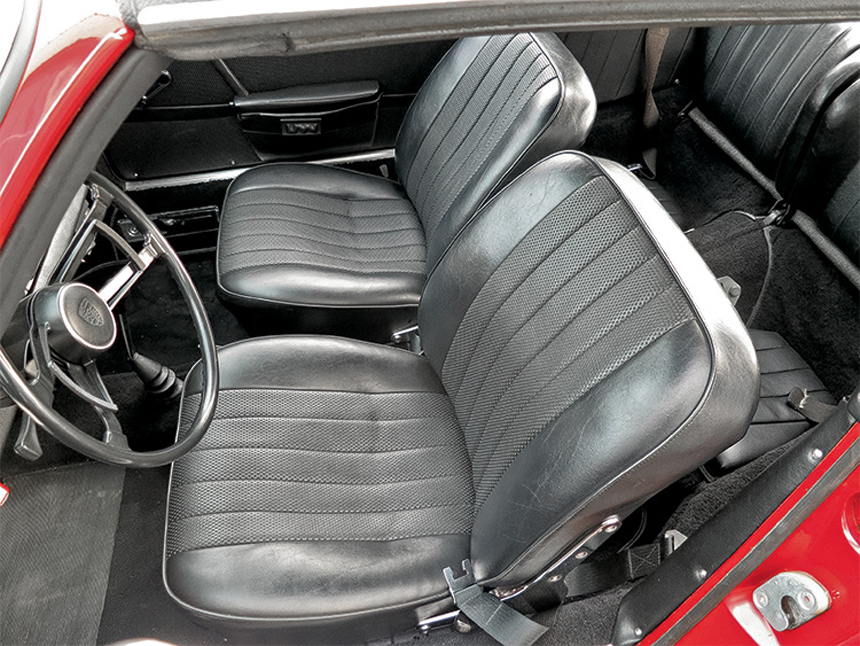
Funny chairs with short backs, lap belts, tightness in the back… And on the floor between the chairs there are two levers – “handbrake” plus a control lever for the independent gasoline heater
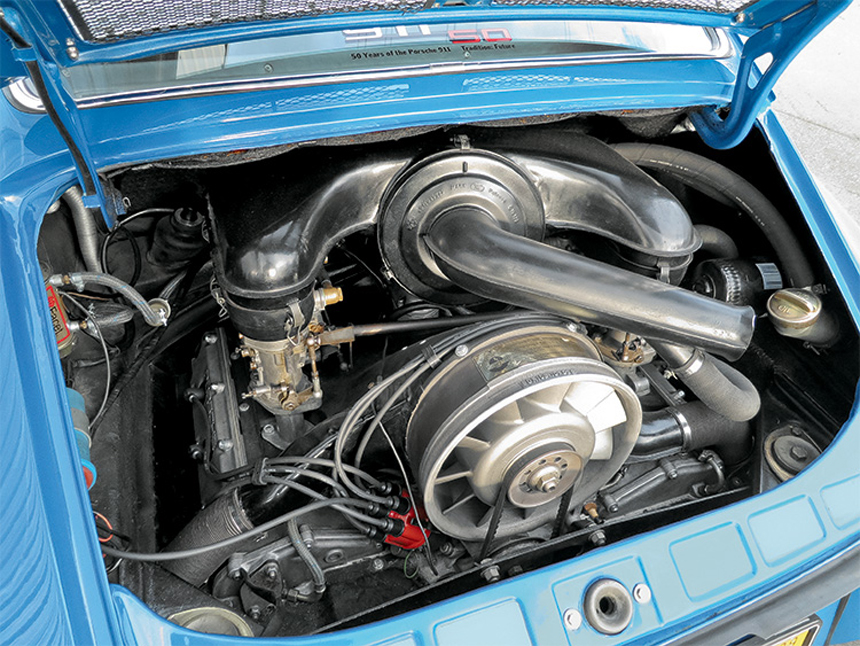
“If I had known in those years that this engine would eventually be bored out to 3.3 liters, I would have asked the designers to reduce the safety margin to make it lighter,” Ferry Porsche later admitted. “What a blessing that I didn’t do that then…”
By the early ’70s, the Porsche executive team was filled with engineers. And all of them—Furmann, Helmut Bott, and even the chief designer Tony (or Anatoly Fyodorovich) Lapin—considered rear-engine layout in the 911 a flaw, an anachronism, a whim of the late Ferdinand Porsche. Their verdict was clear: send the “rear-engine car” to the scrap heap, as Lapin called the Porsche 911!
On that board in Bott’s office, as Peter Schulz recalls, the 911 model line ended in 1982. And instead, a new era of front-engine models began—the Porsche 924/944 with Volkswagen components and the Porsche 928 with a V8 engine, which began production in the mid-’70s. Automotive journalists of that time noted that all of them were more stable and safer than the “911.” While previously, the Porsche 911 lineup had as many as seven versions (three coupes with different engines, three Targas, and the semi-racing Carrera RS), by 1979-1982, only three remained.
Were Furmann and his colleagues right? From the perspective of those years, yes. But how many roads to hell are paved with good intentions…
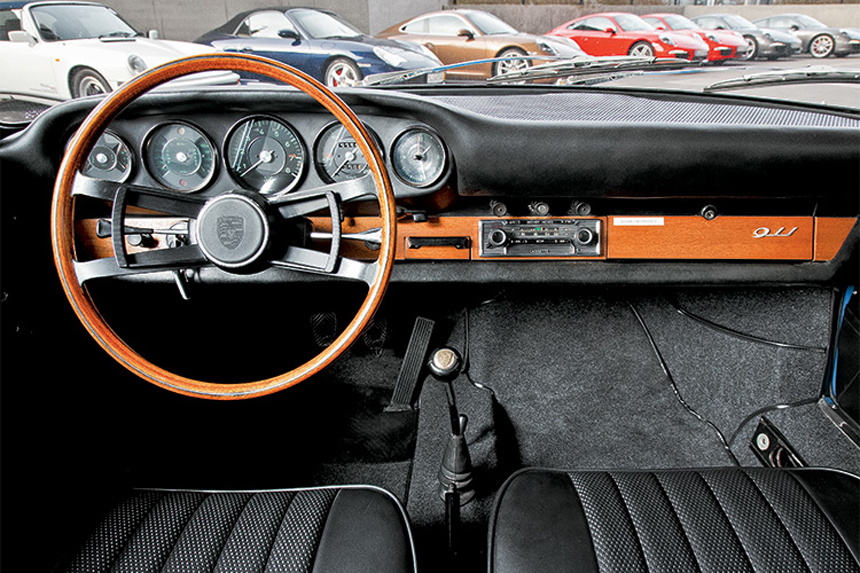
The huge and thin steering wheel almost lies on your knees, the horn is activated by two triggers, and the five-speed gearshift lever is long-stroke and not the most precise. There are five scales, the main one is a tachometer
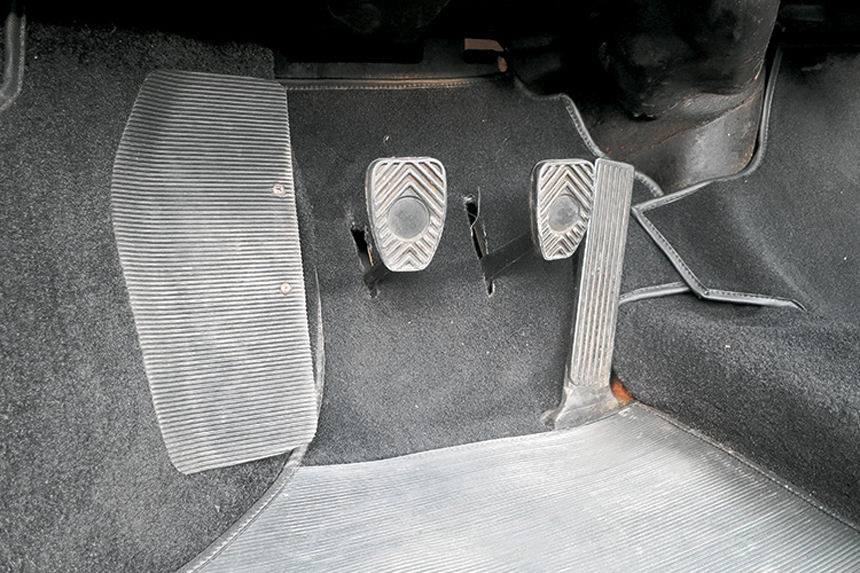
All the pedals are on the floor: if the gas is convenient, then the brake and clutch are relics of the past
And do you know what saved the Porsche 911—and the company itself? America.
Today, Porsche AG’s sales in the U.S. account for just a quarter of their global sales. But back then, it was at least 60%—sometimes even up to 70%! Why did these small—by American standards, tiny!—teardrop-shaped, agile cars become so beloved across the ocean?
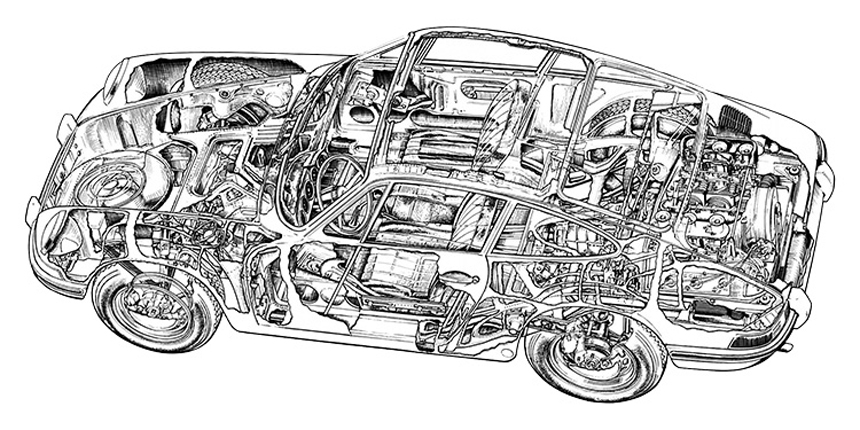
These technical drawings clearly show that the design of the Porsche 911 has not changed for a quarter of a century – both the first cars

and the cars of the mid-seventies
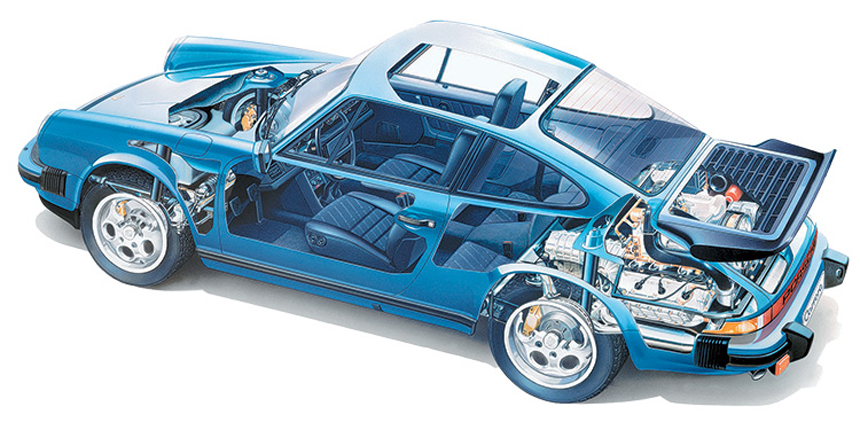
and the turbo version with a separate factory code 930 of the 1974 model (below) have a torsion bar suspension – front McPherson “candles” and rear oblique triangular levers. But thanks to constant modernization, the handling of the early and late “nine hundred and elevenths” is like heaven and earth!
It all started in the late ’40s when Max Hoffman, the son of Austrian immigrants (the family fled the Nazis to America via Paris), began selling European cars in New York. If you remember, it was Hoffman who insisted that Mercedes make the production 300 SL “Gullwing.” He was the one who popularized the Volkswagen Beetle and Jaguar in the U.S., and thanks to him, masterpieces like the Porsche 356 Speedster, Alfa Romeo Giulietta Spider, or the “Baroque Angel” BMW 507 were introduced.
Hoffman also created a trend for Porsche among the American elite, skillfully playing into the fascination with everything infernal. After all, Ferdinand Porsche was Hitler’s favorite designer! And victorious America was so indulgent and curious about all things German…
In the ’50s, most of the Porsche 356 cars were bought by Americans, and over time, this passion shifted to the Porsche 911. But it wasn’t about “sportiness” per se: of the 16,000 Porsches sold worldwide in 1966, 9,000 were four-cylinder versions of the Porsche 912, made exclusively for the U.S.! Slow and calm.
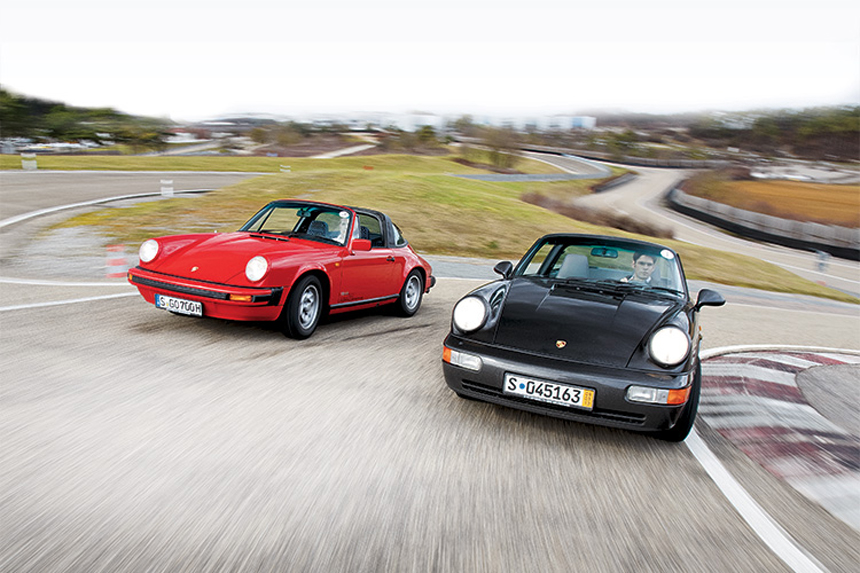
What a “delicious” test track in Weissach! Behind you is the fast section with the running left, and then you dive right and up the hill – and on unloading you go left, like these two “classics”. On the outer radius is a Porsche 911 Targa of the so-called G-series from the mid-seventies, and on the inner – the next-generation Targa of the 964 series from 1989: finally with spring suspension and power steering. But the 964 series cars were only produced for four years!
The more refined front-engine Porsche 924/944 and 928 models never caught on in America—there were plenty of “ordinary” cars there. So, Ferry Porsche, against the 1972 agreement, intervened in the management of the company. He ousted Furmann and appointed Peter Schulz, an American, as president.
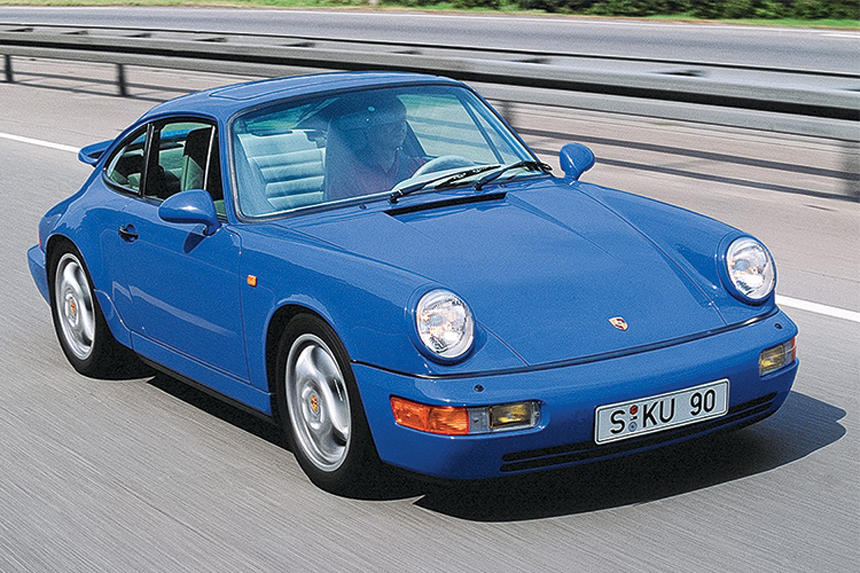
Well, not quite American—he was a Jewish refugee, whose family escaped the Nazi persecutions, fleeing to Cuba in 1937 and then moving to Chicago. A talented businessman, Schulz had successfully raised sales for heavy machinery brands like Caterpillar, Cummins, and Klökner-Humboldt-Deutz. At Porsche, Schulz initiated the development of a proper 911 Cabriolet (since 1982), and in 1983, under his leadership, the “Turbolook” appeared—naturally aspirated 911s with a Turbo body kit. Engineer Furmann, by the way, was against the “Turbolook” and rightly argued that the 50 kg of extra weight didn’t help with handling. But sales were great!
The Porsche 911 was saved. Work on modernization began—this time more seriously: the new Porsche 911 series 964, released in 1989, finally got a spring suspension instead of the torsion bars inherited from the pre-war Beetle.
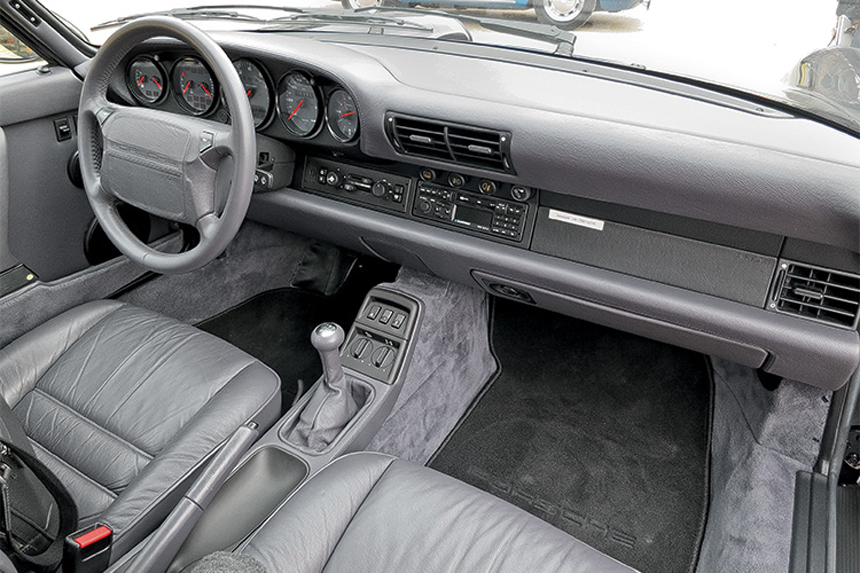
Interior of the all-wheel drive Porsche 911 series 964 anniversary edition of 1993 before the change of generations
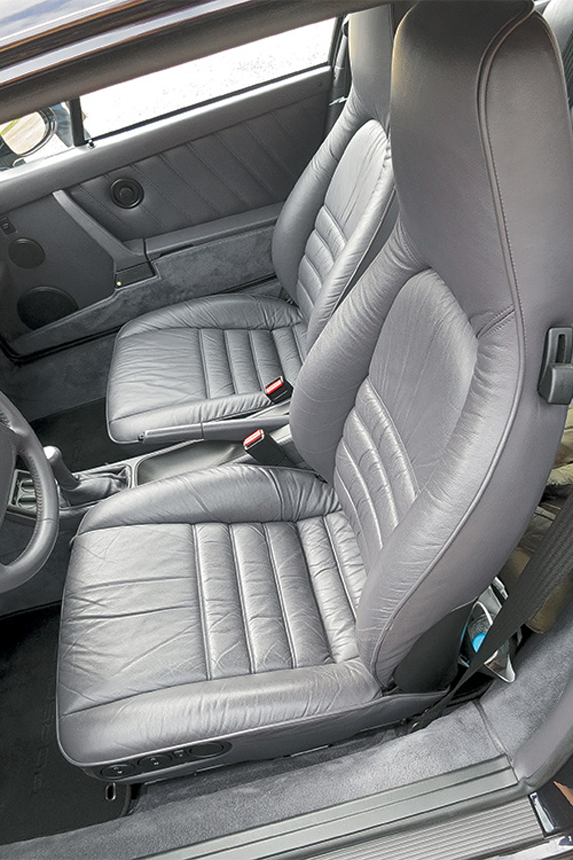
Excellent integral seats, impeccable finishing, comfortable steering wheel… And only the “mechanics” lever would like to be more precise
By the way, the all-wheel-drive Porsche 911 series 964 came to market earlier than the rear-wheel-drive version. I drove such a 964 in Weissach, a special 1993 anniversary edition produced to mark the 30th anniversary of the 911. A neat interior, the thrilling sound of the “boxer” engine, decent acceleration—though not the fastest by today’s standards. And a wonderful, balanced chassis, with the ability to manually lock the front-wheel drive coupling.
Why all-wheel-drive? The 3.6L engine doesn’t impress with its torque—only 250 hp. That’s just slightly more than the 4-cylinder BMW M3 E30, and with the 280-hp “six” of the next-generation M3, it’s incomparable!
Handling. Fighting the “dark side of rear-engine” – the risk of oversteering when lifting off the throttle in a corner.
In Schulz’s memoirs, there’s an interesting episode. He writes about how, in the early ’80s, an Australian Porsche importer came to his office and began questioning why the company was still making “a car that requires above-average driving skills.” Schulz, an amateur pilot, responded by referencing his flying experience. Yes, flying modern planes with a three-point landing gear is more convenient and safer. But the thrill you get when you land a pre-war fighter perfectly, with no mistakes, is unmatched! And everyone on the ground watches you with a respectful gaze—they understand you’re a master behind the wheel…
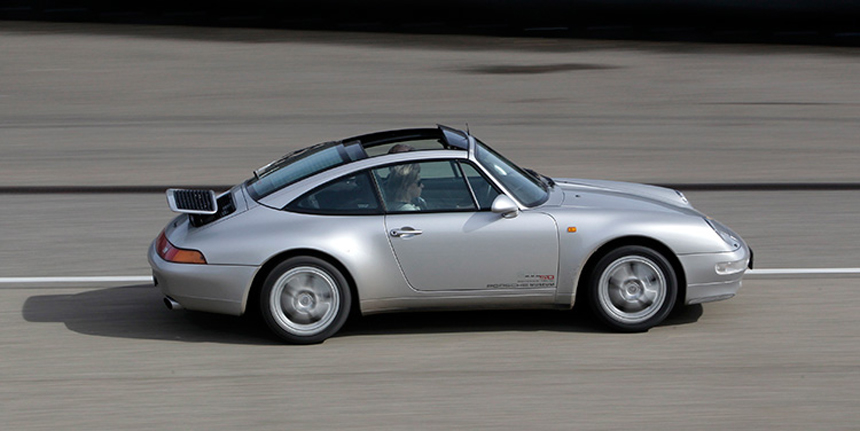
The Porsche 911 series 993 with a multi-link rear suspension was also not a long-liver – it was on the assembly line for only four years, from 1994 to 1997. In the photo is a rare American version of the Targa: without a powerful roof crossbar, but simply with a large sliding hatch
He convinced the Australian, and a few weeks later, he received as a gift a tailwheel from a WWII fighter, with the inscription “To the Porsche tail-wheel philosophy.” But how much effort Porsche put into ensuring that a powerful rear-engine car kept its unique character and became safe!
And for the first thirty-plus years, the struggle had mixed results. I got behind the wheel of the 993 Porsche 911—a 1995 Targa with a four-speed “automatic,” purely an American version, and on winter tires—and… the “boxer” engine of the same 3.6L capacity as the previous 964 models now produces 285 hp, the Mercedes “automatic” works well, and the dynamics are truly engaging. Reactions are sharper and quicker—the car now has a multi-link rear suspension. But when lifting off the throttle in a quick corner—you’re sideways!

Compare this interior of the 993 series car with the one above: doesn’t it look like its predecessor, the 964 series?
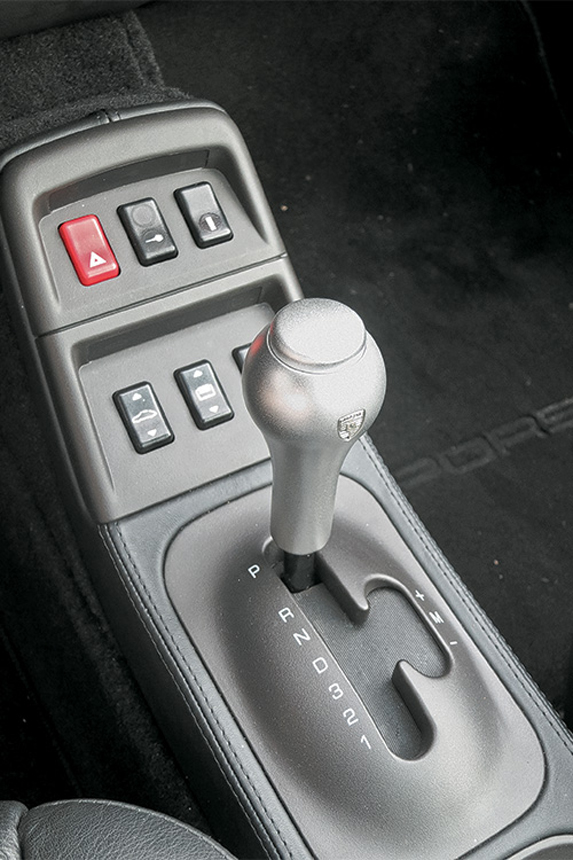
A full-fledged “automatic” appeared on the Porsche 911 only in 1990, but it was Tiptronic – with the ability to manually select sequential gears
The dangerous tendency to oversteer was “cured” only in the next generation, with the factory code 996—completely new, with liquid-cooled engines. I still remember our first test drive in 1997: how cautious I was with the “traitor”—and how thrilled we were, leaving the car behind. Lofty, feminine, thrilling—even despite the squeaky plastic buttons.
So, how many generations of the Porsche 911 have there been? When you dive into the technical history, you realize that all the cars with “air-cooled” engines, up to the 996 series, were essentially the same design. From 1964 to 1998! But—with a series of updates and facelifts. So, in the history of the 911, there were two eras—the “air-cooled” and the “liquid-cooled.” The first was the battle for Porsche 911’s survival. The second—the era of the triumph of “rear-engine philosophy.” Look around—now every sports car manufacturer is aiming for a 40:60 weight distribution in favor of the rear wheels! And the Porsche 911 has had this from the very start. It seemed like this chassis couldn’t be perfected any further. But then came the Porsche 911 series 997, then the facelifted 997.2 with PDK, and now the stunning “991.” Each time—faster, better, sharper, more precise. And the “dark side of rear-engine” hasn’t been mentioned in years—it was completely conquered in the late ’90s with the 996 generation. Since then—only brighter, only more vibrant.
And all thanks to the Porsche family. Thanks to Ferdinand, the designer of the Beetle and pre-war Auto Union and Cisitalia racing cars. Thanks to his children and grandchildren—Ferry Porsche, Butzi Porsche, Ferdinand Piëch—who stuck to their vision, no matter what even their closest associates advised. Family business—the strongest. “We chose the rear-engine layout because we didn’t believe in the long-term potential of the front-engine layout,” Ferry Porsche recalled. That’s how you should think—thinking in terms of half a century.
And when I look at the celebratory photograph with seven generations of the Porsche 911, taken right before my eyes on a square with half-timbered houses somewhere between Stuttgart and Weissach… Yes, I would count only six generations, and American enthusiasts, for example, distinguish as many as twelve. But how symbolic this number is now—seven.
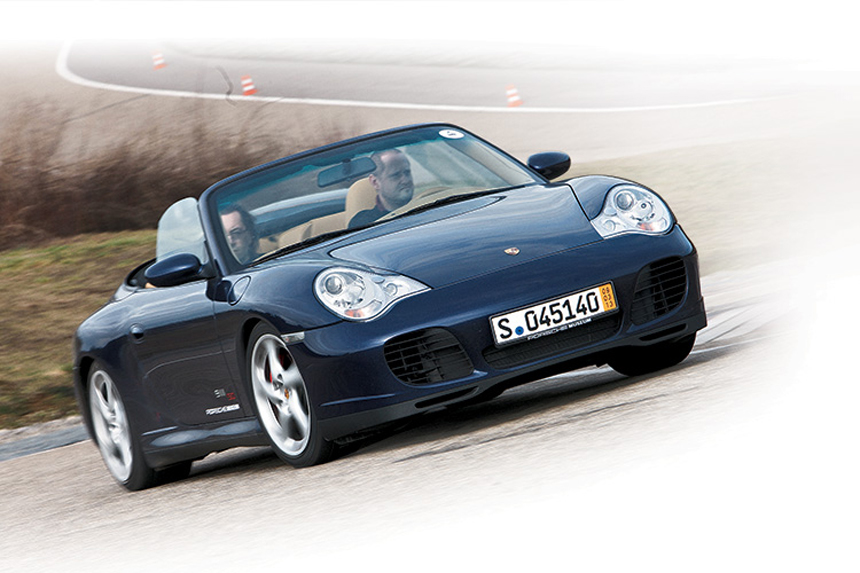
This time I didn’t get to ride the Porsche 911 series 996 (1998-2004), but I remember our impressions of those times: shock, space, fantasy! In fact, the subsequent models of the 997 and 991 series are a development of this car
Photo: Porsсhe | Leonid Golovanov
This is a translation. You can read the original article here: Почему официально поколений у Porsche 911 семь: где граница между первым и вторым?

Published May 08, 2025 • 16m to read

